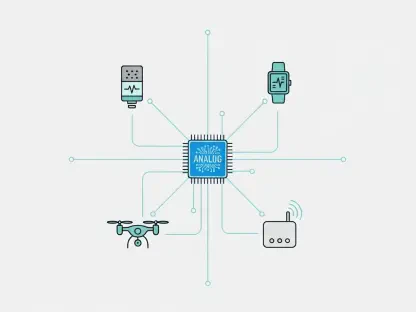In an era where artificial intelligence is reshaping the technological landscape at an unprecedented pace, Arm Holdings, a heavyweight in the semiconductor industry, is making a seismic shift that could redefine its future. Traditionally recognized for licensing its chip architecture to tech giants like Apple and Amazon, Arm is now venturing into uncharted territory by focusing on in-house AI chip development. This strategic pivot is not merely a response to market trends but a bold attempt to position itself as a direct rival to dominant players like NVIDIA in the rapidly expanding AI semiconductor space. With the recruitment of top-tier talent and a vision to capitalize on the AI boom, Arm is laying the groundwork for a transformative journey that could alter the competitive dynamics of the industry. This move raises intriguing questions about how the company will balance innovation with existing partnerships while navigating a crowded and fiercely competitive market.
Driving Forces Behind the Strategic Shift
The catalyst for Arm Holdings’ dramatic change in direction lies in the explosive growth of the AI semiconductor market, which industry projections suggest could reach $150 billion soon and climb to $500 billion by 2028. This surge is fueled by an insatiable demand for AI accelerators used in data centers, edge computing, and a wide array of enterprise applications. Unlike its historical reliance on licensing intellectual property, Arm is now embracing full-chip development to secure a foothold in this lucrative, high-margin segment. The potential is enormous, with generative AI chips alone expected to constitute over 20% of global chip sales in the coming years. This shift reflects a broader recognition that AI is not just a trend but a fundamental driver of future technology, compelling companies like Arm to adapt or risk being left behind in a rapidly evolving landscape where innovation is the key to survival.
Beyond the sheer market potential, Arm’s pivot is also a calculated response to the changing needs of industries that increasingly rely on specialized AI solutions for efficiency and scalability. The semiconductor space is no longer just about providing raw computing power; it’s about delivering tailored chips that can handle complex machine learning tasks with precision. Data centers, for instance, require chips optimized for massive parallel processing, while edge devices need low-power, high-efficiency solutions. By moving into direct chip design, Arm aims to address these diverse requirements head-on, offering customized accelerators that can compete with the best in the business. This strategic realignment positions the company to tap into multiple high-growth areas simultaneously, potentially redefining its role from a behind-the-scenes enabler to a frontline innovator in the AI-driven tech ecosystem.
Building a Powerhouse Team for AI Innovation
Central to Arm Holdings’ ambitious foray into AI chip development is the strategic recruitment of Rami Sinno, a seasoned expert who previously spearheaded AI chip initiatives at Amazon Web Services. With a proven track record of developing custom chips like Trainium and Inferentia, Sinno brings invaluable expertise to Arm, where he is tasked with leading the creation of specialized AI accelerators. His mission is clear: to craft solutions that can stand toe-to-toe with industry giants like NVIDIA in the critical areas of AI training and inference. This high-profile hire signals Arm’s intent to not just participate in the AI market but to challenge the established order with cutting-edge technology designed for specific, high-demand applications across various sectors.
Complementing Sinno’s appointment, Arm has also bolstered its ranks with other industry veterans, including Nicolas Dube from Hewlett Packard Enterprise and Steve Halter, who brings experience from Intel and Qualcomm. These additions to the systems design team highlight a deliberate effort to build a robust foundation of expertise capable of navigating the complexities of AI chip development. Each of these professionals contributes a unique perspective, from advanced system architecture to optimizing performance for real-world applications. Together, they form a formidable unit aimed at accelerating Arm’s transition from a licensing-focused entity to a comprehensive player in the semiconductor space. This influx of talent underscores a commitment to innovation, suggesting that Arm is preparing for a long-term battle to redefine its identity in a competitive and fast-moving industry.
Opportunities and Challenges in a Crowded Market
The AI-driven semiconductor market presents a staggering opportunity, with forecasts indicating that the broader industry could exceed $1 trillion by 2030. Arm’s emphasis on chiplet technology and modular designs offers a promising avenue for delivering scalable and cost-effective solutions that appeal to cloud providers and enterprise clients alike. Strategic collaborations, such as those with Databricks for optimizing AI workloads, and potential manufacturing partnerships with industry leaders like TSMC, point to an expedited development timeline that could give Arm a competitive edge. These alliances are crucial, as they enable the company to leverage external expertise and infrastructure, potentially reducing time-to-market for its innovative AI chips and positioning it as a serious contender in a space hungry for novel solutions.
However, this bold pivot is not without significant risks, particularly in terms of maintaining harmony with long-standing partners like Apple and NVIDIA, who have relied on Arm’s architecture for their own chip designs. As Arm transitions into a direct competitor, there is a tangible danger of straining these relationships, which could have ripple effects on its existing business model. The competitive landscape is already crowded with established giants and agile startups, each vying for a share of the AI pie. Navigating this delicate balance—between pursuing aggressive innovation and preserving critical alliances—will be a defining challenge for Arm. The stakes are high, as any misstep could undermine years of trust and collaboration, potentially impacting revenue streams that have historically been the backbone of the company’s success.
Industry Trends Shaping the Future
Across the semiconductor industry, a pronounced shift toward specialization in AI and machine learning applications is evident, driven by escalating demand in sectors like data centers, smartphones, and edge infrastructure. The rise of advanced packaging technologies and chiplets is transforming how chips are designed and manufactured, with production capacity expected to double by 2026. Arm’s deep-rooted expertise in modular design aligns perfectly with these emerging trends, offering a potential advantage in creating flexible, efficient solutions for diverse use cases. This alignment is not merely coincidental but a strategic asset, as the industry moves toward systems that prioritize adaptability and performance over one-size-fits-all approaches, positioning Arm to capitalize on the next wave of technological advancement.
Moreover, the consensus among industry analysts and leaders is that AI chips represent a strategic imperative for any serious player in the semiconductor space. The high margins and growth potential associated with this segment make it a focal point for investment and innovation. Arm’s decision to dive into this area reflects a broader industry movement where companies are racing to develop specialized hardware that can handle the unique demands of AI workloads. From optimizing neural networks to enabling real-time processing at the edge, the push for AI-specific solutions is reshaping competitive priorities. For Arm, staying ahead in this race means not only keeping pace with technological advancements but also anticipating future needs, ensuring that its offerings remain relevant in an ever-shifting market landscape.
Reflecting on a Bold Transformation
Looking back, Arm Holdings embarked on a daring journey by shifting its focus to AI chip development, a decision underscored by the recruitment of exceptional talent like Rami Sinno and a clear-eyed view of market potential. The path was fraught with challenges, from navigating intense competition to managing delicate partner dynamics, yet the company’s commitment to innovation through modular designs and strategic alliances laid a strong foundation. As the AI revolution gained momentum, Arm’s efforts to carve out a space in this high-stakes arena were marked by calculated risks and a vision for long-term impact. Moving forward, the focus should be on accelerating the adoption of its AI accelerators, deepening collaborations to refine technology, and continuously monitoring market shifts to stay ahead of rivals. The semiconductor landscape remains dynamic, and Arm’s ability to adapt and innovate will determine its lasting influence in shaping the future of technology.









